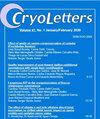Subtle membrane changes in cryopreserved bull spermatozoa when modified temperature drop rates are used during the first phase of freezing.
IF 1
4区 生物学
Q3 BIOLOGY
引用次数: 1
Abstract
BACKGROUND Cryopreservation of spermatozoa involves reduction of temperature to a subzero level, leading to increased longevity. However, temperature reduction has a significant effect on sperm membranes. OBJECTIVE To evaluate the impact of the rate of temperature drop during the first phase of freezing on subtle membrane changes in cryopreserved bull spermatozoa. MATERIALS AND METHODS Thirty-two ejaculates from four bulls (eight ejaculates/bull) were collected using artificial vagina while keeping a 3 to 4 days gap between two collections. Diluted semen samples were equilibrated at 5 degree C for 4 hours. The samples were then placed in a pre-programmed semen freezer. The first phase of freezing, that is, 5 degree C till -10 degree C was subjected to three different temperature drop rates: accelerated (F1), moderate (F2), and slow (F3), at 20 degree C per min, 10 degree C per min and 5 degree C per min, respectively. After thawing, spermatozoa were assessed for percentage live, plasma, and acrosomal membrane integrity, along with the external appearance of phosphatidyl serine, indicating apoptosis. RESULTS A significant difference (p < 0.05) in viability, plasma membrane integrity (HOS test), and acrosome membrane integrity (PSA test) was observed between F3 and the other groups. However, the parameters did not significantly differ between F1 and F2. The annexin V-PI assay (AN/PI) categorized four types of sperm populations: non-apoptotic and viable (AN-/PI-), apoptotic and viable (AN+/PI-), non-apoptotic and non-viable (AN-/PI+), and apoptotic and non-viable (AN+/PI+). The proportion of spermatozoa with (AN-/PI-) and (AN+/PI+) differed significantly (p < 0.05) between F3 and the other groups. The values for apoptotic and viable (AN+/PI-) and non-apoptotic and non-viable (AN-/PI+) sperm were not significantly different among all freezing categories. CONCLUSION A slower temperature drop rate (freezing rate) during the first phase of freezing results in less damaging, subtle membrane changes. Doi.org/10.54680/fr24410110312.在冷冻的第一阶段改变温度下降率时,冷冻保存的公牛精子膜发生微妙变化。
背景精子的冷冻保存包括将温度降至零度以下,从而延长精子的寿命。材料和方法使用人工阴道收集四头公牛的 32 滴精液(每头公牛 8 滴),两次收集间隔 3 到 4 天。稀释后的精液样本在 5 摄氏度下平衡 4 小时。然后将样本放入预设的精液冷冻机中。冷冻的第一阶段,即从 5 摄氏度到-10 摄氏度,有三种不同的降温速率:加速(F1)、中速(F2)和慢速(F3),降温速率分别为每分钟 20 摄氏度、每分钟 10 摄氏度和每分钟 5 摄氏度。解冻后,对精子的活率、质膜和顶体膜的完整性以及磷脂酰丝氨酸的外观进行评估,磷脂酰丝氨酸表示精子凋亡。结果观察到 F3 组与其他组在活力、质膜完整性(HOS 试验)和顶体膜完整性(PSA 试验)方面存在显著差异(p < 0.05)。然而,F1 和 F2 之间的参数没有明显差异。附件素 V-PI 试验(AN/PI)将精子分为四种类型:未凋亡且存活的精子(AN-/PI-)、凋亡且存活的精子(AN+/PI-)、未凋亡且未存活的精子(AN-/PI+)和凋亡且未存活的精子(AN+/PI+)。F3和其他组之间,(AN-/PI-)和(AN+/PI+)的精子比例差异显著(p < 0.05)。结论 在冷冻的第一阶段,较慢的温度下降速度(冷冻速度)会导致较少的破坏性微妙膜变化。Doi.org/10.54680/fr24410110312.
本文章由计算机程序翻译,如有差异,请以英文原文为准。
求助全文
约1分钟内获得全文
求助全文
来源期刊

Cryo letters
生物-生理学
CiteScore
1.80
自引率
10.00%
发文量
50
审稿时长
1 months
期刊介绍:
A bimonthly international journal for low temperature sciences, including cryobiology, cryopreservation or vitrification of cells and tissues, chemical and physical aspects of freezing and drying, and studies involving ecology of cold environments, and cold adaptation
The journal publishes original research reports, authoritative reviews, technical developments and commissioned book reviews of studies of the effects produced by low temperatures on a wide variety of scientific and technical processes, or those involving low temperature techniques in the investigation of physical, chemical, biological and ecological problems.
 求助内容:
求助内容: 应助结果提醒方式:
应助结果提醒方式:


